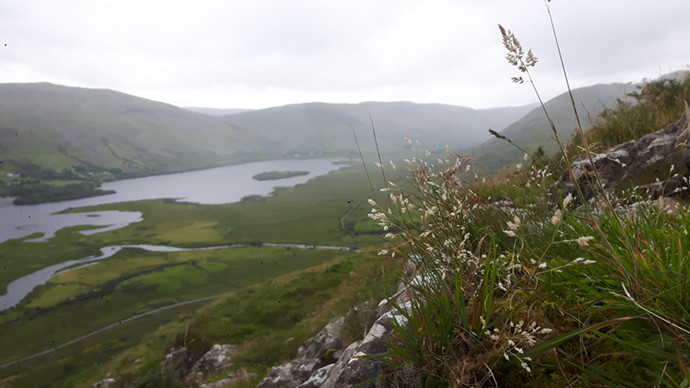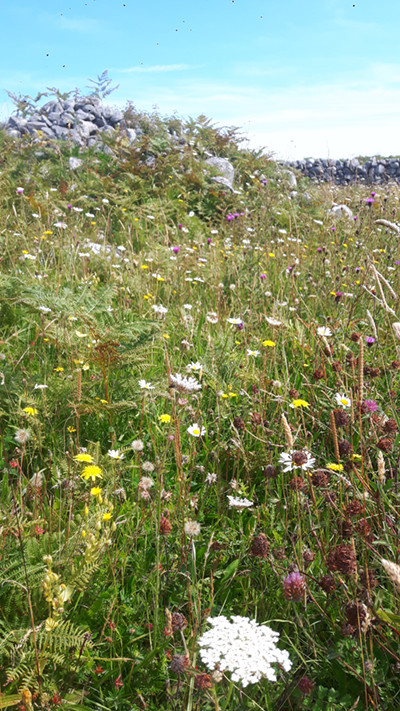Semi-natural grasslands are hugely important reservoirs for biodiversity, supporting a diverse range of plant and animal species. They also perform a wide range of other ecosystem services such as healthy soil, climate regulation, flood attenuation, etc. In Ireland we are lucky to have large areas of semi-natural grassland, including six types which are listed for protection on the EU Habitats Directive (listed below). Sadly, however, these are now among the most threatened habitat types in Ireland.

In this part of the world, grasslands need management. Without a least periodic grazing or mowing most grassland areas would become rank, scrubby, or invaded by other species (e.g. bracken, bramble, shrubs and trees). Woodlands and scrub are of course valuable habitats in their own right, but it is a shame to lose all the wondrous biodiversity and other values of semi-natural grasslands to newly spreading bracken or scrub. (Woodland creation should in general be focused on less valuable habitats, e.g. improved grasslands.)
Farming and semi-natural grassland conservation go hand-in-hand. The importance of farmers in maintaining our high-nature-value farmland and semi-natural grasslands cannot be overstated. Awareness of why semi-natural grasslands are valuable, how to recognise them, and how best to manage them, can be patchy however. Through dialogue, liaison and awareness-raising, both within and outside of the agricultural communities, it is hoped to work to improve this.
Grassland types found in Ireland which are listed on the EU Habitats Directive
- Orchid-rich calcareous grassland
- Lowland hay meadow (traditionally managed meadows with high species richness)
- Molinia meadow (wettish grasslands with purple moor grass and high species richness)
- Nardus grassland (acid grasslands, usually in the uplands)
- Hydrophilous tall herb (community dominated by herbs, with upland and lowland variants)
- Calaminarian grassland (community dominated by mosses and found on mine waste)
Where to find further information
Some of the publications detailing grassland surveys in Ireland can be found by clicking the following links:
- Irish Semi-natural Grasslands Survey (2007-2012) main report
- Grassland Monitoring Survey report (2015-2017)
- Article 17 reports – from early 2019, giving most recent updates on conservation status of each habitat type
You can view data from the Irish Semi-natural Grasslands Survey spatially via this online map viewer. Just choose ‘Irish Semi-Natural Grassland Dataset’.
Develop your knowledge
If you are interested in learning to identify grasses, sedges, or grassland types, please visit the webpage of the NPWS-funded Irish Grasslands Project, run by the BSBI. Here you can find links on the right-hand side to ‘Training course recordings’. These are an excellent resource, and are highly recommended. The five topics are as follows:
- Introduction to Grass ID (presented by Fionnuala O'Neill)
- Vegetative Grass ID part 1 (presented by Lynda Weekes)
- Vegetative Grass ID part 2 (presented by Lynda Weekes)
- Introduction to Sedge ID (presented by Lynda Weekes)
- Introduction to Annex I Grasslands (presented by Fionnuala O'Neill)
Below are links to two talks by NPWS grassland ecologist Dr Maria Long, both covering many aspects relating to semi-natural grasslands in Ireland. The first gives a broad view, aimed at the general public, while the second is a little more focused on agricultural management and on the threat posed by increasing nutrient levels.
- Talk on semi-natural grasslands in Ireland for Burren In Bloom festival, June 2020.
- Semi-natural grasslands in Ireland - precious resources under threat - talk for Teagasc, October 2020.
New ‘Great Irish Grasslands’ website
A new website has recently been launched where you can find out more about Ireland’s semi-natural grasslands and hear about events. Visit greatirishgrasslands.ie.
Members of the Scientific Unit can be contacted by e-mailing natureconservation@npws.gov.ie.

